
Llywelyn ap Gruffudd, sometimes written as Llywelyn ap Gruffydd, also known as Llywelyn the Last, was the native Prince of Wales from 1258 until his death at Cilmeri in 1282. Llywelyn was the son of Gruffydd ap Llywelyn Fawr and grandson of Llywelyn the Great, and he was one of the last native and independent princes of Wales before its conquest by Edward I of England and English rule in Wales that followed, until Owain Glyndŵr held the title during the Welsh Revolt of 1400–1415.
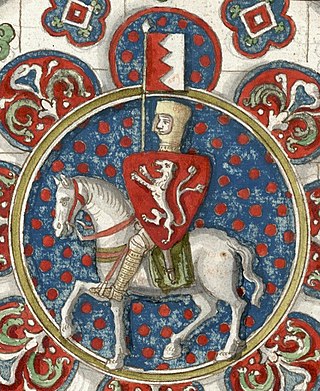
Simon de Montfort, 6th Earl of Leicester, later sometimes referred to as Simon V de Montfort to distinguish him from his namesake relatives, was a nobleman of Norman French origin and a member of the English peerage, who led the baronial opposition to the rule of King Henry III of England, culminating in the Second Barons' War. Following his initial victories over royal forces, he became de facto ruler of the country, and played a major role in the constitutional development of England.
The Battle of Evesham was one of the two main battles of 13th century England's Second Barons' War. It marked the defeat of Simon de Montfort, Earl of Leicester, and the rebellious barons by the future King Edward I, who led the forces of his father, King Henry III. It took place on 4 August 1265, near the town of Evesham, Worcestershire.

Eleanor de Montfort, Princess of Wales and Lady of Snowdon was an English noble and Welsh Princess. She was the daughter of Simon de Montfort, 6th Earl of Leicester and Eleanor of England. She was also the second woman who can be shown to have used the title Princess of Wales.
Edmund, 1st Earl of Lancaster, also known by his epithet Edmund Crouchback, was a member of the royal Plantagenet Dynasty and the founder of the first House of Lancaster. He was Earl of Leicester (1265–1296), Lancaster (1267–1296) and Derby (1269–1296) in England, and Count Palatine of Champagne (1276–1284) in France.

Roger Mortimer, 1st Baron Mortimer of Wigmore, of Wigmore Castle in Herefordshire, was a marcher lord who was a loyal ally of King Henry III of England and at times an enemy, at times an ally, of Llywelyn ap Gruffudd, Prince of Wales.
This article presents a timeline of events in British history from 1000 AD until 1499 AD.

The Treaty of Montgomery was an Anglo-Welsh treaty signed on 29 September 1267 in Montgomeryshire by which Llywelyn ap Gruffudd was acknowledged as Prince of Wales by King Henry III of England. It was the only time an English ruler recognised the right of a ruler of Gwynedd over Wales. Llywelyn's grandfather Llywelyn the Great had previously laid claim to be the effective prince of Wales by using the title "Prince of Aberffraw, Lord of Snowdon" in the 1230s, after subduing all the other Welsh dynasties. Likewise Llywelyn's uncle, Dafydd ap Llywelyn, claimed the title of Prince of Wales during his reign from 1240 to 1246. However, Llywelyn's supremacy in the late 1260s forced recognition of his authority in Wales by an English Crown weakened by internal division.
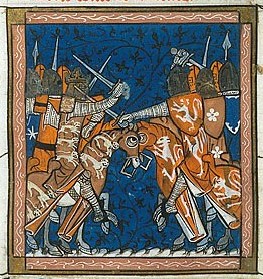
The Second Barons' War (1264–1267) was a civil war in England between the forces of a number of barons led by Simon de Montfort against the royalist forces of King Henry III, led initially by the king himself and later by his son, the future King Edward I. The barons sought to force the king to rule with a council of barons, rather than through his favourites. The war also involved a series of massacres of Jews by de Montfort's supporters, including his sons Henry and Simon, in attacks aimed at seizing and destroying evidence of baronial debts. To bolster the initial success of his baronial regime, de Montfort sought to broaden the social foundations of parliament by extending the franchise to the commons for the first time. However, after a rule of just over a year, de Montfort was killed by forces loyal to the king at the Battle of Evesham.
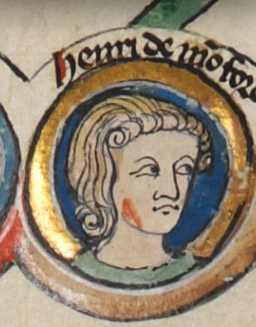
Sir Henry de Montfort was the son of Simon de Montfort, 6th Earl of Leicester, and with his father played an important role in the struggle of the barons against King Henry III. Henry's mother was Princess Eleanor of England, a daughter of King John, whose marriage to Simon further increased the foreign influence begun by the king, which was to result in great hostility by those very barons who later revolted against the king.
Madog II was a Prince of Powys Fadog from 1269 to 1277.
This article is about the particular significance of the century 1201–1300 to Wales and its people.
Events from the 1260s in England.
Events from the 1240s in England.

Wales in the High Middle Ages covers the 11th to 13th centuries in Welsh history. Beginning shortly before the Norman invasion of the 1060s and ending with the Conquest of Wales by Edward I between 1278 and 1283, it was a period of significant political, cultural and social change for the country.
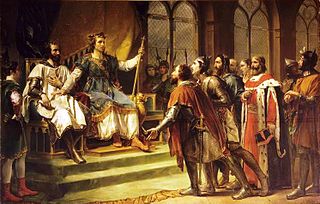
The Mise of Amiens was a settlement given by King Louis IX of France on 23 January 1264 in the conflict between King Henry III of England and his rebellious barons, led by Simon de Montfort. Louis' one-sided decision for King Henry led directly to the hostilities of the Second Barons' War.
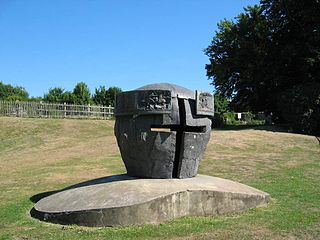
The Mise of Lewes was a settlement made on 14 May 1264 between King Henry III of England and his rebellious barons, led by Simon de Montfort. The settlement was made on the day of the Battle of Lewes, one of the two major battles of the Second Barons' War. The conflict between king and magnates was caused by dissatisfaction with the influence of foreigners at court and Henry's high level and new methods of taxation. In 1258 Henry had been forced to accept the Provisions of Oxford, which essentially left the royal government in the hands of a council of magnates, but this document went through a long series of revocations and reinstatements. In 1263, as the country was on the brink of civil war, the two parties had agreed to submit the matter to arbitration by the French king Louis IX. Louis was a firm believer in the royal prerogative, and decided clearly in favour of Henry. The outcome was unacceptable for the rebellious barons, and war between the two parties broke out almost immediately.
Pipton is a small settlement and former civil parish in Powys, Wales on the Afon Llynfi near its confluence with the River Wye. It was formerly in the county of Brecknockshire and is now part of the community of Bronllys. The nearest town is Hay-on-Wye some 5 miles (8.0 km) to the east.
William Devereux, was an important Marcher Lord, and held Lyonshall Castle controlling a strategically vital approach to the border of Wales. The castle's significance was heightened by the rebellion of Llywelyn ap Gruffudd, Prince of Wales. With strong family ties to the politically powerful families of Cantilupe and Giffard, his support was strongly sought after by Henry III and Simon de Montfort throughout the Second Barons' War.

Y Gorddwr was a medieval commote in the cantref of Ystlyg in the Kingdom of Powys. It was on the eastern side of the River Severn bordering England, on the west it was bordered by two of the other commotes of Ystlyg - Deuddwr in the north and Ystrad Marchell in the south. Its Welsh name could mean "the upper water"; gor- "upper-", dŵr "water".










